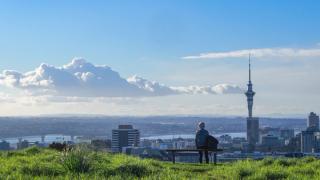
Learnings from the New Zealand Sustainability Leaders Summit 2023
- Post Date
- 28 November 2023
- Read Time
- 4 minutes

The inaugural Sustainability Leaders Summit took place in Auckland on November 22, building on the success of prior events in Melbourne. Executives, leaders, subject matter experts, and sustainability professionals from across Aotearoa New Zealand shared insights from their work and discussed key trends shaping the path towards a more sustainable future.
Sessions at the summit covered topics ranging from supply chain, customer engagement on sustainability, sustainability challenges, and implementation of sustainability from the board to employees. A few of the main takeaways were:
1. Responding to climate impacts now and in the future
When asked what’s shaping the future of sustainability, the impacts of climate change that are being felt today was very much front of mind. Emily Davies of Tower Insurance cited that they paid the equivalent of five years of claims in the two weeks following the Auckland Anniversary floods and Cyclone Gabrielle earlier this year. Beyond the immediate tactical actions of responding to these events, they are also discussing introducing new products such parametric insurance to adapt their business to the new reality.
2. Leveraging mandatory reporting for action
Multiple speakers described a “seismic shift in reporting” with the implementation of The Financial Sector (Climate-related Disclosures and Other Matters) Amendment Act 2021 (CRD Act) rapidly approaching, among other existing and forthcoming mandatory reporting requirements across jurisdictions. Finance and risk teams are more involved than ever in understanding and managing sustainability.
For Chris Thurston of Watercare, the introduction of CRD reporting requirements is allowing the organization to operationalize climate resilience through multibillion-dollar investments over the next several years. Emma Coote of OfficeMax NZ noted that as mandatory reporting requirements have increased, internal reporting requirements have also increased which in turn is driving strategy and initiatives throughout business across functions/roles.
3. Opportunities and risks in the transition from voluntary to mandatory reporting
While many companies have been preparing voluntary sustainability reports for several years, these have often faced a tension between being used as marketing material vs a transparent accounting of progress on sustainability.
Hannah Bain of Russell McVeagh identified significant potential of litigation & compliance risk over climate and other sustainability claims given this tension. However, she also expects there will be many learnings from reports released over the next year, with alignment and consolidation of standards internationally a key trend to monitor. Continuing transparency and honesty in reporting on progress will also unlock opportunities for collaboration.
4. Looking beyond direct operations to achieve goals
Collaboration is essential to achieving impact at the scale necessary to solve the most pressing challenges. Expanding beyond direct operational impact to collaborate and committing to partnership unlocked opportunities for several speakers. For example, Pip Newland of Orion New Zealand is working with landowners to develop carbon credits. Meanwhile, Olivia Barclay of The Warehouse Group discussed how they were able to create a long-term power-purchase agreement (PPA) with Lodestone Energy to drastically reduce emissions from electricity.
Working within your value chain can also address multiple priorities simultaneously. For instance, while climate was front of mind for much of the day, the associated compliance risk may extend into the supply chain via Scope 3, and increasing traceability may also support identification, mitigation and reporting of modern slavery as these laws are coming into force globally. Simon Tucker of Fonterra and Michael Anderson of Graincorp (a Fonterra supplier) discussed the ways in which they are working with each other and other suppliers and customers to achieve Scope 3 emissions reduction targets.
While each of these takeaways are valuable in and of themselves, taken together, they show that a key to “sustainability leadership” is thinking beyond the most immediate or direct problem. To solve the scale and scope of challenges facing us, businesses will need to innovate, seek opportunities and not just react to risk, and find partners and collaborators to commit to solutions together.
Recent posts
-

-

An update on environmental permitting for hydrogen production by electrolysis
by Esha Lovatt
View post -
